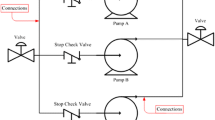Abstract
In safety critical applications, it becomes common to improve the reliability through k-out-of-n redundancy. In this research, the authors have presented an analytical approach to compute the reliability measures of a system, which contains a mixed configuration. The system consists of three subsystems, namely A, B and C, connected in mixed configurations (i.e. combination of series and parallel configuration). Subsystem A is of the type 1-out of-2:G. Subsystem A is connected to subsystem B in a parallel configuration and these two subsystems are connected in series configuration with subsystem C. The considered system has three states, namely, good, degraded and failed. Markov process, supplementary variable technique and Laplace transformation have been used for solution and reliability measures like availability, reliability, mean time to failure, sensitivity analysis and cost-effectiveness have been evaluated of the considered system.







Similar content being viewed by others
References
Andrews JD, Moss TR (1993) Reliability and risk assessment. Longman Scientific and Technical (Essex, England and New York, NY). ISBN 0470233451
Arjan JC, Gemund V, Reijns GL (2012) Reliability analysis of k-out-of-n system single cold standby using Pearson distribution. IEEE Trans Reliab 61(3):526–532
Azaron A, Katagiri H, Kato K, Masatoshi S (2006) Reliability evaluation of multi-component cold-standby redundant system. Appl Math Comput 173:137–149
Borgonovo E (2010) The reliability importance of components and prime implicants in coherent and non-coherent systems including total-order interactions. Eur J Oper Res 204(3):485–895
Chan F-Y, Chan LK, Lin GD (1988) On consecutive-k-out-of-n: F systems. Eur J Oper Res 36(2):207–216
Chander S, Mukender S (2009) Probabilistic analysis of a 2-out-of-3 redundant system subject to degradation. J Appl Probab Stat 4(1):33–44
Chung WK (1984) A k-out-of-n: G redundant system with cold standby units and common cause failure. Microelectron Reliab 24(4):691–695
Coit DW (2001) Cold standby redundancy optimization for non-repairable systems. IIE Trans 33(6):471–478
Csenki A (1995) A dependability measure for Markov models of repairable systems: solution by randomization and computational experience. Comput Math Appl 30(2):95–110
Ebrahimipur V, Qurayshi SF, Shabni A, Maleki-Shoja B (2011) Reliability optimization of multi-state weighted k-out-of-n systems by fuzzy mathematical programming and genetic algorithm. Int J Syst Assur Eng Manag 2(4):312–318
El-Said KM, El-Sherbeny MS (2010) Stochastic analysis of a two-unit cold standby system with two stage repair and waiting time. Indian J Stat 73(1):1–10
Eryilmaz S (2012) Reliability of combined m-consecutive-k-out of-n: F and consecutive-kc-out-of-n: F systems. IEEE Trans Reliab 61(1):215–219
Eryilmaz S (2012) On the mean residual life of a k-out-of-n: G system with a single cold standby component. Eur J Oper Res 222(2):273–277
Gupta PP, Agarwal SC (1984) A parallel redundant complex system with two types of failure under preemptive-repeat repair discipline. Microelectron Reliab 24(3):395–399
Gupta PP, Agarwal SC (1984) Cost function analysis of a 3-state reparable system. Microelectron Reliab 24(1):51–53
Henley EJ, Kumamoto H (1992) 1992. IEEE Press, Probabilistic Risk Assessment
Hong JS, Koo HY, Lie CH (2002) Joint reliability importance of k-out-of-n systems. Eur J Oper Res 142(3):539–547
Kumar A, Ram M (2013) Reliability measure improvement and sensitivity analysis of a coal handling unit for a thermal power plant. Int J Eng 26(9):1059–1066
Kumar J, Kadyan MS, Malik SC (2013) Profit analysis of a 2-out-of-2 redundant system with single standby and degradation of the units after repair. Int J Syst Assur Eng Manag 4(4):424–434
Lam Y, Ng HKT (2001) A general model for consecutive k-out-of-n: F repairable system with exponential distribution and (k−1)-step Markov dependence. Eur J Oper Res 129(3):663–682
Majeed AR, Sadiq NM (2006) Availability and Reliability evaluation of Dokan hydro power station. IEEE PES Transmission and Distribution Conference and Exposition Latin America, Venezuela, pp 1–6
Papageorgiou E, Kokolakis G (2010) Reliability analysis of a two-unit general parallel system with (n-2) warm standby. Eur J Oper Res 201(3):821–827
Pham H (2010) On the estimation of Reliability of k-out-of-n systems. Int J Syst Assur Eng Manag 1:32–35
Pham H, Suprasad A, Misra RB (1996) Reliability and MTTF prediction of k-out-of-n complex systems with components subjected to multiple stages of degradation. Int J Syst Sci 27(10):995–1000
Ram M, Singh SB, Singh VV (2013) Stochastic analysis of a standby system with waiting repair strategy. IEEE Trans Syst Man Cybern Syst 43(3):696–707
Rodríguez-Velázquez JA, Kamišalić A, Domingo-Ferrer J (2009) On reliability indices of communication networks. Comput Math Appl 58(7):1433–1440
Salehfar H, Trihadi S (1998) Application of perturbation analysis to sensitivity computations of generating units and system reliability. IEEE Trans Power Syst 13(1):152–158
Shi Y, Kou K, Li X (2006) Estimation of reliability indexes for a cold standby system under type II censoring data. J Phys Sci 10:85–92
Sridharan V (2007) Availability analysis of series system with cold standby components and general time repair. Appl Sci 9:155–162
Trivedi KS (2002) Probability and Statistics with reliability. Queuing and computer Science Applications, John Wiley and sons Inc, New York
Wang GJ, Zhang YL (2007) An optimal replacement policy for a two-component series system assuming geometric process repair. Comput Math Appl 54(2):192–202
Xing L, Dugan JB (2002) Analysis of generalized phased-mission system reliability, performance, and sensitivity. IEEE Trans Reliab 51(2):199–211
Zhang T, Horigome M (2001) Availability and reliability of system with dependent components and time-varying failure and repair rates. IEEE Trans Reliab 50(2):151–158
Acknowledgments
The authors would like to thank the anonymous reviewers and the Editor-in-Chief of the Journal for their valuable suggestions and critical comments which help a lot in improving the quality and clarity of the paper. Authors are also thankful to the Research and Development Department of the Graphic Era University, Dehradun, India for the facilities provided for the research work.
Author information
Authors and Affiliations
Corresponding author
Additional information
Technical Editor: Marcelo A. Trindade.
Rights and permissions
About this article
Cite this article
Ram, M., Kumar, A. Performability analysis of a system under 1-out-of-2:G scheme with perfect reworking. J Braz. Soc. Mech. Sci. Eng. 37, 1029–1038 (2015). https://doi.org/10.1007/s40430-014-0227-y
Received:
Accepted:
Published:
Issue Date:
DOI: https://doi.org/10.1007/s40430-014-0227-y




